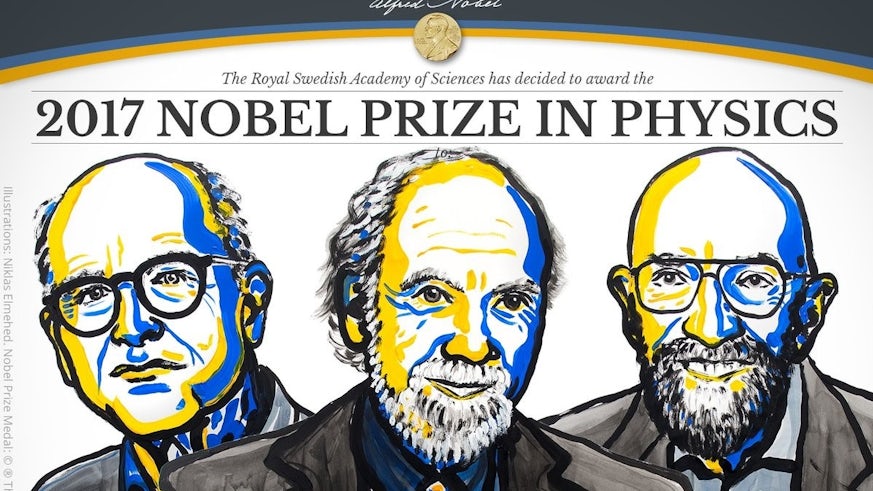LIGO scientists celebrate Nobel Prize
3 October 2017

Cardiff University’s Gravitational Physics Group are celebrating the awarding of this year’s Nobel Prize in Physics to Rainer Weiss, Barry C. Barish and Kip S. Thorne.
The Nobel Prize in Physics 2017 was divided, one half awarded to Rainer Weiss, the other half jointly to Barry C. Barish and Kip S. Thorne "for decisive contributions to the LIGO detector and the observation of gravitational waves".
Gravitational waves are tiny ripples in space-time that are emitted as a result of violent cosmic events, such as exploding stars and merging black holes. These waves were first predicted by Albert Einstein in 1916 as a consequence of his general theory of relativity, and were first detected by the LIGO team 100 years after Einstein made his predictions.
A network of three highly sensitive detectors in Louisiana, Washington (as part of LIGO) and Pisa (as part of Virgo) have detected four gravitational wave signals between them to date, and continue to scan the sky for the elusive signals.
Research undertaken at Cardiff University has laid the foundations for how we go about detecting gravitational waves with the development of novel algorithms and software that have now become standard search tools for detecting the elusive signals.
The Gravitational Physics Group also includes world-leading experts in the collision of black holes, who have produced large-scale computer simulations to imitate these violent cosmic events and predict how gravitational waves are emitted as a consequence. These calculations were instrumental in decoding all four of the observed gravitational-wave signals to date and to measure the properties of the black holes that were detected.
“It took 100 years to confirm the existence of gravitational waves but our observations over the past two years have already raised questions about the formation and evolution of black holes and allowed us to test Einstein's gravity to incredibly greater precision than was possible before. We are beginning to understand if Nature's black holes are truly spacetime warpage as predicted by general relativity and if the nature of gravitational waves is as predicted by Einstein."
“The LIGO-Virgo network of detectors have truly begun a new chapter in astronomy. This year's prize is a befitting reward to this new endeavour, which promises to provide deeper insights into how the Universe works,” Professor Sathyaprakash continued.
Professor Mark Hannam, from the School of Physics and Astronomy, said: “LIGO has already given us a string of discoveries -- the first direct detection of gravitational waves, the first observation of a binary black hole system, the first observation of black holes several tens of times more massive than the sun, and arguably the first direct observation of a black hole. But the truly incredible achievement was to make the LIGO detectors. We already knew gravitational waves existed. We already knew black holes existed. What Weiss, Barish and Thorne did was to build the first machine sensitive enough to be able to directly measure gravitational waves.
“It took them over forty years, and the result was the most sensitive measuring device ever made. It is an incredible new tool that has only begun to transform our understanding of the universe.”

"The excitement surrounding this award recognises not only the fundamental contributions made by Weiss, Barish and Thorne to opening the gravitational-wave sky, but also the tremendous potential of gravitational waves as an entirely new way to look at the Universe. We’ve already learned that black hole mergers are much more common than we thought, and it’s likely that nature will have more surprises for us in the coming years. We may even see entirely new objects that we haven’t even imagined yet."
Share this story
It is a friendly, approachable School with a strong commitment to teaching excellence and world class research in physics and astronomy.




